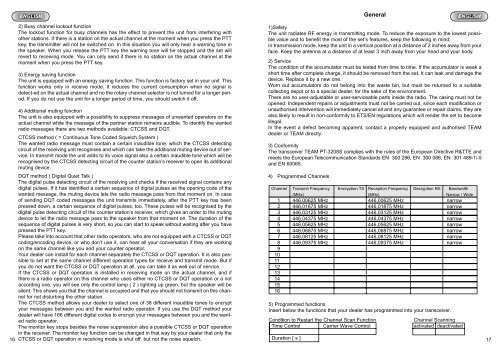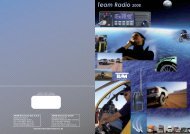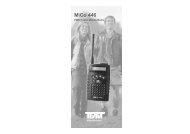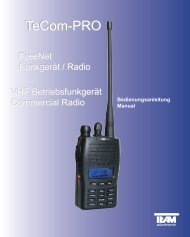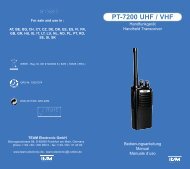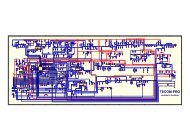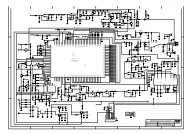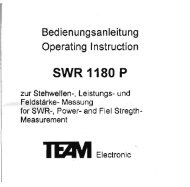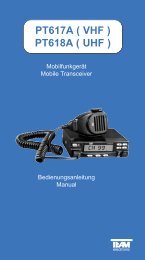TEAM PT3208S - Team Electronic
TEAM PT3208S - Team Electronic
TEAM PT3208S - Team Electronic
Create successful ePaper yourself
Turn your PDF publications into a flip-book with our unique Google optimized e-Paper software.
16<br />
ENGLISH<br />
2) Busy channel lockout function<br />
The lockout function for busy channels has the effect to prevent the unit from interfering with<br />
other stations. If there is a station on the actual channel at the moment when you press the PTT<br />
key, the transmitter will not be switched on. In this situation you will only hear a warning tone in<br />
the speaker. When you release the PTT key the warning tone will be stopped and the set will<br />
revert to receiving mode. You can only send if there is no station on the actual channel at the<br />
moment when you press the PTT key.<br />
3) Energy saving function<br />
The unit is equipped with an energy saving function. This function is factory set in your unit. This<br />
function works only in receive mode. It reduces the current consumption when no signal is<br />
detect-ed on the actual channel and no the rotary channel selector is not turned for a longer period.<br />
If you do not use the unit for a longer period of time, you should switch it off.<br />
4) Additional muting function<br />
The unit is also equipped with a possibility to suppress messages of unwanted operators on the<br />
actual channel while the message of the partner station remains audible. To identify the wanted<br />
radio messages there are two methods available: CTCSS and DQT.<br />
CTCSS method ( = Continuous Tone Coded Squelch System )<br />
The wanted radio message must contain a certain inaudible tone, which the CTCSS detecting<br />
circuit of the receiving unit recognises and which can take the additional muting device out of service.<br />
In transmit mode the unit adds to its voice signal also a certain inaudible tone which will be<br />
recognised by the CTCSS detecting circuit of the counter station’s receiver to open its additional<br />
muting device.<br />
DQT method ( Digital Quiet Talk )<br />
The digital pulse detecting circuit of the receiving unit checks if the received signal contains any<br />
digital pulses. If it has identified a certain sequence of digital pulses as the opening code of the<br />
wanted message, the muting device lets the radio message pass from that moment on. In case<br />
of sending DQT coded messages the unit transmits immediately, after the PTT key has been<br />
pressed down, a certain sequence of digital pulses, too. These pulses will be recognised by the<br />
digital pulse detecting circuit of the counter station’s receiver, which gives an order to the muting<br />
device to let the radio message pass to the speaker from that moment on. The duration of the<br />
sequence of digital pulses is very short, so you can start to speak without waiting after you have<br />
pressed the PTT key.<br />
Please take into account that other radio operators, who are not equipped with a CTCSS or DQT<br />
coding/encoding device, or who don’t use it, can hear all your conversation if they are working<br />
on the same channel like you and your counter operator.<br />
Your dealer can install for each channel separately the CTCSS or DQT operation. It is also possible<br />
to set at the same channel different operation types for receive and transmit mode. But if<br />
you do not want the CTCSS or DQT operation at all, you can take it as well out of service.<br />
If the CTCSS or DQT operation is installed in receiving mode on the actual channel, and if<br />
there is a radio operator on this channel who uses either no CTCSS or DQT operation or a not<br />
according one, you will see only the control lamp ( 2 ) lighting up green, but the speaker will be<br />
silent. This shows you that the channel is occupied and that you should not transmit on this channel<br />
for not disturbing the other station.<br />
The CTCSS method allows your dealer to select one of 38 different inaudible tones to encrypt<br />
your messages between you and the wanted radio operator. If you use the DQT method your<br />
dealer will have 166 different digital codes to encrypt your messages between you and the wanted<br />
radio operator.<br />
The monitor key stops besides the noise suppression also a possible CTCSS or DQT operation<br />
in the receiver. The monitor key function can be changed in that way by your dealer that only the<br />
CTCSS or DQT operation in receiving mode is shut off, but not the noise squelch.<br />
General<br />
1)Safety<br />
The unit radiates RF energy in transmitting mode. To reduce the exposure to the lowest possible<br />
value and to benefit the most of the set’s features, keep the following in mind:<br />
In transmission mode, keep the unit in a vertical position at a distance of 2 inches away from your<br />
face. Keep the antenna at a distance of at least 3 inch away from your head and your body.<br />
2) Service<br />
The condition of the accumulator must be tested from time to time. If the accumulator is weak a<br />
short time after complete charge, it should be removed from the set. It can leak and damage the<br />
device. Replace it by a new one.<br />
Worn out accumulators do not belong into the waste bin, but must be returned to a suitable<br />
collecting depot or to a special dealer, for the sake of the environment.<br />
There are no user-adjustable or user-serviceable parts inside the radio. The casing must not be<br />
opened. Independent repairs or adjustments must not be carried out, since each modification or<br />
unauthorised intervention will immediately cancel all and any guarantee or repair claims, they are<br />
also likely to result in non-conformity to ETS/EN regulations which will render the set to become<br />
illegal.<br />
In the event a defect becoming apparent, contact a properly equipped and authorised <strong>TEAM</strong><br />
dealer or <strong>TEAM</strong> directly.<br />
3) Conformity<br />
The transceiver <strong>TEAM</strong> PT-3208S complies with the rules of the European Directive R&TTE and<br />
meets the European Telecommunication Standards EN 300 296, EN 300 086, EN 301 489-1/-5<br />
and EN 60065.<br />
4) Programmed Channels<br />
ENGLISH<br />
Channel Transmit Frequency Encryption TX Reception Frequency Decryption RX Bandwidth<br />
(MHz) (MHz) Narrow / Wide<br />
1 446,00625 MHz 446,00625 MHz narrow<br />
2 446,01875 MHz 446,01875 MHz narrow<br />
3 446,03125 MHz 446,03125 MHz narrow<br />
4 446,04375 MHz 446,04375 MHz narrow<br />
5 446,05625 MHz 446,05625 MHz narrow<br />
6 446,06875 MHz 446,06875 MHz narrow<br />
7 446,08125 MHz 446,08125 MHz narrow<br />
8 446,09375 MHz 446,09375 MHz narrow<br />
9<br />
10<br />
11<br />
12<br />
13<br />
14<br />
15<br />
16<br />
5) Programmed functions<br />
Insert below the functions that your dealer has programmed into your transceiver.<br />
Condition to Restart the Channel Scan Function Channel Scanning<br />
Time Control Carrier Wave Control activated deactivated<br />
Duration [ s ]<br />
17


